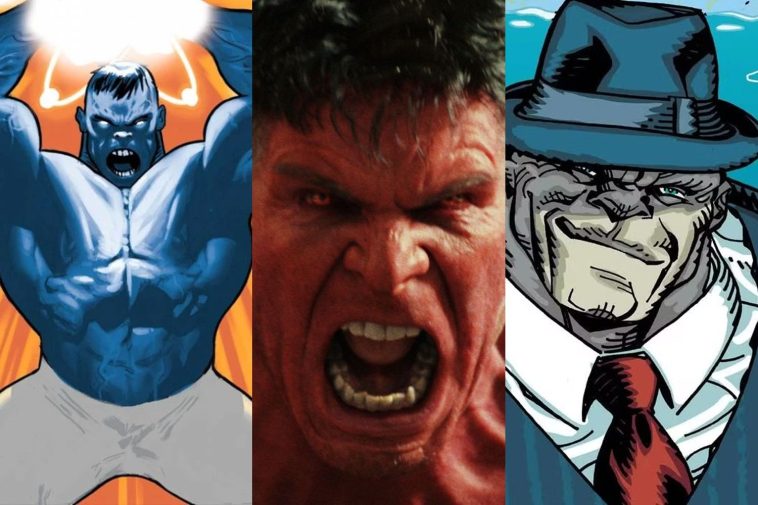We all know the Incredible Hulk. He’s big, we won’t like it when he’s angry, and, of course, he’s very, very green. But that’s not the only hue Bruce Banner, or several other characters to take on the irradiated moniker of Hulk, has been over the years. As the MCU prepares for Captain America: Brave New World to add the latest splash to its Hulk palette in Thaddeus Ross’ crimson carnage causer, here’s a brief run down of the rainbow of Hulks from the comics and beyond.
Brown © Marvel Comics The occasional color of many forms of the Devil Hulk—an alternate persona within Bruce Banner’s psyche that embodied both Bruce’s negative traits as well as his own self-loathing perspective of his plight. Although as an aspect of Bruce’s mind, always threatening to break out, the Devil Hulk has had differing forms across its appearances—it returned again in 2018’s Immortal Hulk as the dominant personality, following Bruce’s death and resurrection after the events of Civil War II—its debut marked this significant color differential.
First Appearance: 2000
Reason for color: Not given, other than he has a more monstrous, reptilian form compared to the regular Hulk.
Blue © Marvel Comics Many heroes over the years have harbored the cosmic, god-like force that transforms a host into Captain Universe, Hulk included—albeit only briefly. Although originally green when he first encountered it, the Enigma Force enhanced Bruce’s abilities to give him a strength boost across the board, but also transformed him into a shade of blue the first time he tried to use the power. Realizing is wildly increased strength, the Hulk declared his new form the strongest he’d ever been, only for the Enigma Force to vacate and search for a new host.
First Appearance: 2005
Reason for color: The Enigma Force transforms all of its hosts with an astral-themed makeover when they bond.
Orange © Marvel Comics Several Hulks from alternate realities have used an orange coloration—the Hulk of the infamous X-Men alternate timeline, the Age of Apocalypse, considered himself the “Solar Hulk,” while in an alternate reality where Bruce Banner became Sorcerer Supreme, he managed to separate his consciousness from the Hulk and exile it to Hell, transforming the Hulk into a fiery demon intent on re-possessing Bruce’s body.
First Appearance: 2011
Reason for color: The Hulk of the Age of Apocalypse timeline was orange due to getting his power from solar radiation. Infernal Hulk, meanwhile, turned demonically orange due to being banished to Hell.
Purple © Marvel Comics Likewise, there have been a few instances of a Hulk turning Purple. The first saw Bruce possessed by the sinister Sorcerer Supreme of an alternate reality, Shanzar, during an adventure with his fellow Defenders Doctor Strange and Namor. The other notable one wasn’t Bruce at all, but Norman Osborn: working with AIM after his plans to usurp SHIELD with HAMMER were exposed, Norman was given Super Adaptoid technology which he used to absorb all the powers of the Avengers at once, Hulk included… and nearly killing himself in the process. Outside of the comics, Happy Hogan became a purple Hulk during the events of the What If…? animated series, after being exposed to Bruce’s radioactive blood.
First Appearance: 1990
Reason for color: Demonic possession; being stupid enough to absorb the powers of multiple conflicting Avengers at once.
Yellow © Marvel Comics A version of AIM also had a role in a briefly appearing version of the Hulk where Bruce had been corrupted by the group and forced into working as their agent, now in an appropriately AIM-ian shade of yellow. It turns out, however, that such a reality was the result of a nightmare dreamed up by Steven Rogers, rather than an actual event.
First Appearance: 2020
Reason for color: AIM brainwashing.
Silver © Marvel Comics The latest shade of Hulk is a bit of a cheat: in a series of new one-shots imagining alternate stories where Galactus didn’t choose Norrin Radd to become his Silver Surfer, Bruce Banner, seeking a way to mitigate the anger issues that drive the Hulk, is chosen instead, giving the usually Green Hulk a coating of cosmic silver. So he’s technically two colors at once.
First Appearance: 2025
Reason for color: The power cosmic, granted by Galactus to people deemed worthy enough to become his herald.
Black © Marvel Comics There have been multiple creatures given the Hulk’s inverted name of “Kluh,” the first being a clone of the Grey Hulk (more on all that later). But the AXIS event gave us a black, rocky-textured version of Bruce that was dubbed Kluh, meant to be a manifestation of Bruce’s unbridled rage, a transformation that to the Hulk what Hulk already was to Bruce Banner. A similar “strongest Hulk” with black coloring appeared in 2022, dubbed as Titan, the unleashed id of the Hulk’s anger.
First Appearance: 2014
Reason for color: Managing to successfully piss off the Hulk as much as it usually takes to piss off Bruce Banner into transforming (with a little help of Chaos-magic-induced personality inversion).
White © Marvel Comics Another cheat, as this coloration has just one appearance in a tounge-in-cheek story in the Strange Tales anthology, alongside a plethora of other colored Hulks as part of the Hulk Squad, an experimental government task force designed to hunt down and beat up the regular Hulk.
First Appearance: 2009
Reason for color: Cloning, and a good gag about rainbow Hulks will never grow old.
Skin Tone © Marvel Comics Not every exposure to gamma radiation turns someone green—several characters have gained Hulk’s powers without any change to their skin color at all. The first was Doc Samson, Bruce Banner’s one-time-psychiatrist after he’d managed to successfully siphon away the gamma radiation that had turned him into the Hulk, found himself exposed to the radiation and turned into a superhuman with Hulk’s powers, but only with his hair turned green. Meanwhile, the Ultimate Marvel universe introduced us to Tyrone Cash—real name Leonard Williams—a former research partner of Bruce Banner who mysteriously vanished, but actually had perfected a Hulk serum inspired by his joint research with Bruce on recreating the Supersoldier serum, becoming the true first Hulk and eventually joining the Ultimates.
First Appearance: 1971, 2010
Reason for color: Alternate exposure to gamma radiation, prototype serum.
Gray © Marvel Comics The Hulk famously started out in comics as gray—a decision made in an attempt to not tie a monstrous, rage-induced creature to the tone of any given ethnic group. But printing limitations with gray at the time made giving the Hulk a consistent shade a challenge, resulting in the decision to make him explicitly green after some printings of the debut issue gave the gray Hulk a greenish tint. But over 20 years after that metatextual swap, a gray Hulk became an actual canonical staple of the character with the introduction of Joe Fixit: meant to be one of several personalities vying for control in Bruce’s psyche, the gray Hulk manifested as a powerful, but more unscrupulous version of Hulk that retained a greater level of intelligence, the gray Hulk eventually adopted the monkier of Fixit, an old-school mobster enforcer.
First Appearance: 1962
Reason for color: Comics printing technology, manifestations of dissociative identity disorder.
Red © Marvel Comics The Hulk we’re about to meet in the MCU, in the comics Thaddeus Ross elected to transform himself into a new kind of Hulk through a supersoldier program developed by the criminal group known as Intelligencia—although his identity was kept secret when he was first revealed for several years. Ross’ Red Hulk had the usual Hulk powers, although to a lesser strength, but he also had heat-generating abilities the angrier he got, capable of expelling that energy as a high-intensity explosive blast. But while the Red Hulk has largely been Ross’ schtick, there was a brief moment during the events of Immortal Hulk where Joe Fixit was exposed to cosmic rays, absorbing them and merging with the green Hulk to take on a red hue.
First Appearance: 2008
Reason for color: Experimentation with a combination of gamma radiation and cosmic rays.
Green © Marvel Comics The Hulk we all know and love after his brief dalliance with gray in his debut. Bruce Banner’s transformation at the hands of gamma radiation created a “savage” alter-ego glowing green with the gamma energy that had saturated his body.
First Appearance: 2000
Reason for color: Exposure to gamma radiation during the testing of an experimental weapon.
Want more io9 news? Check out when to expect the latest Marvel, Star Wars, and Star Trek releases, what’s next for the DC Universe on film and TV, and everything you need to know about the future of Doctor Who.





GIPHY App Key not set. Please check settings